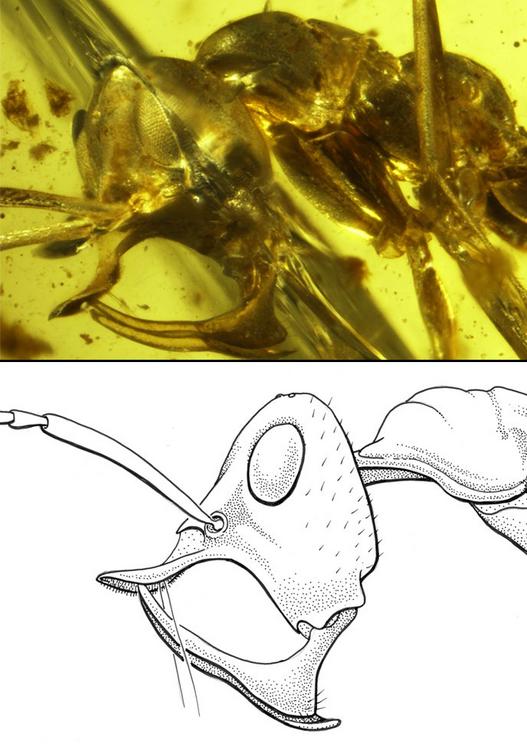Meet the vampire ant from hell with huge jaws and a metal horn
A newly discovered species of prehistoric “hell ant” had anatomy that lived up to its demonic name, including a lethal feeding apparatus reinforced with metal.
Hell ants are an extinct lineage from the Cretaceous Period. Instead of regular mouthparts, they had upward-facing blades.
 Found lurking in amber
Found lurking in amber
No living species have such facial anatomy. However, the hairs around hell ants’ mouths are reminiscent of hairs on modern trap-jaw ants that cause their mouths to snap shut when triggered. This has led to speculation that the hell ants’ mouthparts worked in a similar way.
Some also had a horn-like appendage that jutted out over their tusk-like mandibles. This includes the new species, Linguamyrmex vladi, which Phillip Barden at the New Jersey Institute of Technology in Newark and his colleagues found preserved in 98-million-year-old amber.

Springing the trap
It may be that when another insect brushed the trigger hairs, the blade-like mandibles flipped up and impaled the prey against the horn, punching through its outer layer. “You have this sort of stopping plate, made to accommodate the mandibles closing and capturing prey,” says Barden.
That’s not all. CT scans revealed that L. vladi’s horn was reinforced with metal.
“Probably the metal helps to keep the horn undamaged,” says Vincent Perrichot at the University of Rennes 1 in France. In 2016, he published a description of another horned hell ant, which he called a “unicorn ant”.
“It makes sense to reinforce that [appendage],” agrees Barden, since the horn must have had to withstand repeated impacts from the mandibles. Some modern insects reduce wear and tear in a similar way, by reinforcing their mandibles with metals like zinc and iron.
Metal vampires
As well as being a metal-reinforced unicorn, L. vladi may have been a vampire. When their mandibles moved upwards, they formed a “gutter”. “That might be something that developed to funnel haemolymph – insect blood – down through the mouthparts,” says Barden.

Next to the ant, Barden’s team found a preserved beetle grub – exactly the kind of “squishy, haemolymph-laden insect” that could support a vampiric lifestyle. Perhaps it was next on the menu.
But the metal-reinforced horn suggests that the ants’ jaws moved with enough power to penetrate the tougher cuticles of adult insects as well.
“Until we find a specimen with the prey item trapped, which is probably a matter of time, we’re left to speculate,” says Barden. However, the Myanmar amber deposits where he found his specimen are so rich that more detailed observations are likely to emerge.
Journal reference: Systematic Entomology, DOI: 10.1111/syen.12253

